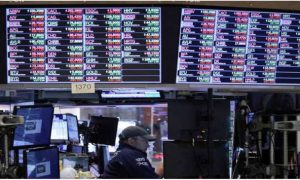U.S. stocks pulled back Tuesday, reflecting a pause after an extended rally.
The S&P 500 fell 0.3%. The tech-heavy Nasdaq Composite fell 0.4%. The Dow Jones Industrial Average rose 0.2%, or 71 points.
Tuesday’s declines bucked a recent trend of stock market gains. The S&P 500 has risen for five consecutive months, including a 3.1% gain in July. Investors have grown more optimistic that the Federal Reserve will be able to engineer a so-called soft landing, by bringing inflation to heel while avoiding a significant economic contraction.
The rally began with shares of big technology companies, but has recently expanded to other parts of the market such as industrial and financial stocks. All 11 sectors of the S&P 500 rose in July.
The recent widespread strength is a sign that bearish investors who have been anticipating a recession are starting to buy in, said Jay Woods, chief market strategist at Freedom Capital Markets. “There have been too many people waiting for an obvious selloff that never happened, and now they have to chase performance.”
Economic data released Tuesday added to hopes that the U.S. economy can steer clear of the worst-case scenario. Job openings declined slightly from the prior month to a seasonally adjusted 9.6 million in June, the Labor Department said. That is the smallest number of available jobs since April 2021, but still well above prepandemic levels.
U.S. manufacturing activity contracted for a ninth consecutive month in July, the Institute for Supply Management said Tuesday. But economic activity within the services sector has remained strong.
Government bond yields climbed as prices fell. The 10-year Treasury yield rose to 4.048%, up from 3.956% Monday. The yield on the 30-year bond rose to 4.104% on Tuesday, its highest level since November 2022.
Read More:- U.S. stocks end a volatile week higher as Dow industrials, S&P 500 notch 3rd straight week of gains
The Treasury Department said Monday it expects to borrow just over $1 trillion in the third quarter. That was $274 billion higher than the previous estimate in May.
Meanwhile, corporate earnings have declined, but not by enough to deflate investor enthusiasm. Second-quarter earnings from S&P 500 companies are down 7.1% from a year earlier, according to a blend of reported results and analyst forecasts provided by FactSet.
But that figure is turning out better than expected: Nearly 83% of companies that have reported earnings have topped Wall Street forecasts, better than the five-year average of 77%. About 58% of S&P 500 companies have already given second-quarter results.
Shares of Caterpillar advanced about 9% Tuesday after the construction-equipment manufacturer said revenue grew 22% in the second quarter. The S&P 500’s top performer was network-equipment maker Arista Networks, which rose 20% Tuesday after reporting results Monday afternoon.
“I think overall, earnings have been a little bit more resilient than expected,” said Kurt Spieler, chief investment officer at FNBO. “The market at the beginning of the year expected much worse.”
Norwegian Cruise Line Holdings stock fell 12% after reporting earnings. Rivals also sold off: Carnival declined 4.5%, while Royal Caribbean fell 1.5%. Spieler said that reflected profit-taking after a strong rally rather than underlying business weakness.
Read More:- Got $1,000? 2 Warren Buffett Stocks to Buy Hand Over Fist
“If you look at that area of the economy, leisure travel is still incredibly strong,” he said.





































